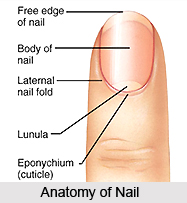 As per the concepts of Ayurveda, the nails are considered as the waste products of the bones. Observation of the shape, size and contours of the nails are crucial in analysing a number of facts about the physical and mental health of an individual. Inference can also be drawn from the flexibility, tenderness or brittleness of nails. Dry, rough and crooked nails which are easily broken signify the predominance of Vata in the body. On contrary if the nails are tender, pink, soft, slightly glistening and bend easily, it indicates the Pitta constitution of an individual. In case the nails are very shiny, soft, strong and thick having a uniform contour it is indicative of the Kapha predominance.
As per the concepts of Ayurveda, the nails are considered as the waste products of the bones. Observation of the shape, size and contours of the nails are crucial in analysing a number of facts about the physical and mental health of an individual. Inference can also be drawn from the flexibility, tenderness or brittleness of nails. Dry, rough and crooked nails which are easily broken signify the predominance of Vata in the body. On contrary if the nails are tender, pink, soft, slightly glistening and bend easily, it indicates the Pitta constitution of an individual. In case the nails are very shiny, soft, strong and thick having a uniform contour it is indicative of the Kapha predominance.
Mal-absorption in the digestive system can be figured out from the longitudinal lines on the nails. When transverse grooves are present on the nails, they reflect either a long-standing illness or defective nutrition. In certain cases the nails assumes a prominent convex and bulbous shape like a drumstick. This condition is known as clubbing and reveals delicate heart and lungs. Concave and spoon shaped nails capable of holding a drop of water indicates iron deficiency in the body. Calcium or zinc deficiency in an individual can be inferred from the white spots present on the nails. A person having excess of red blood cells usually has undue redness on the nails whereas the one suffering from anaemia has pale nails. Jaundice or delicate liver reflects through yellow nails whereas blue nails signify a weak heart.
This article is a stub. You can enrich by adding more information to it. Send your Write Up to content@indianetzone.com




















